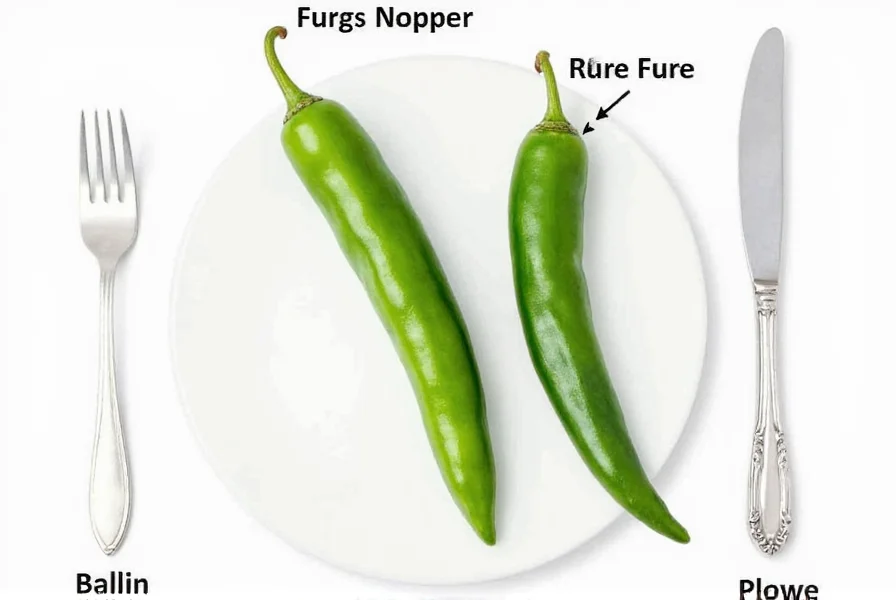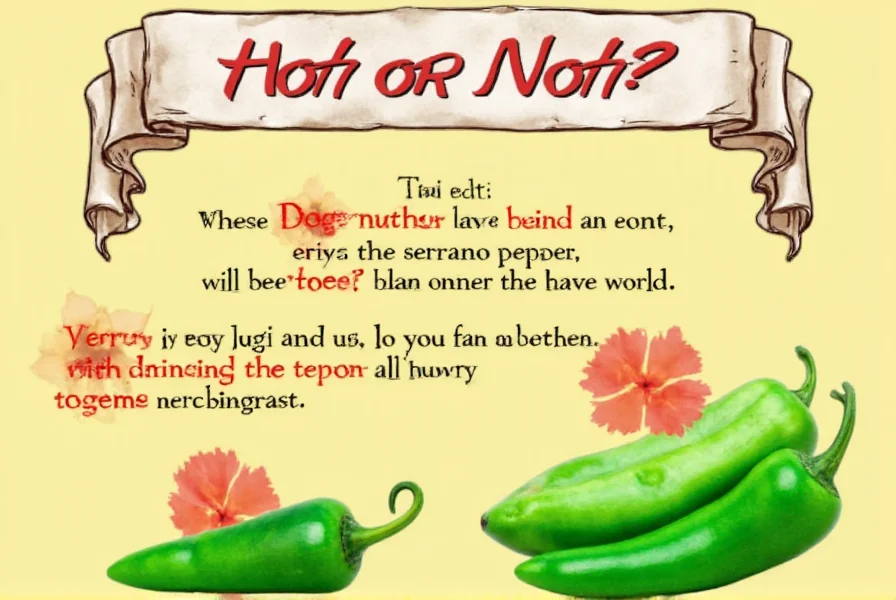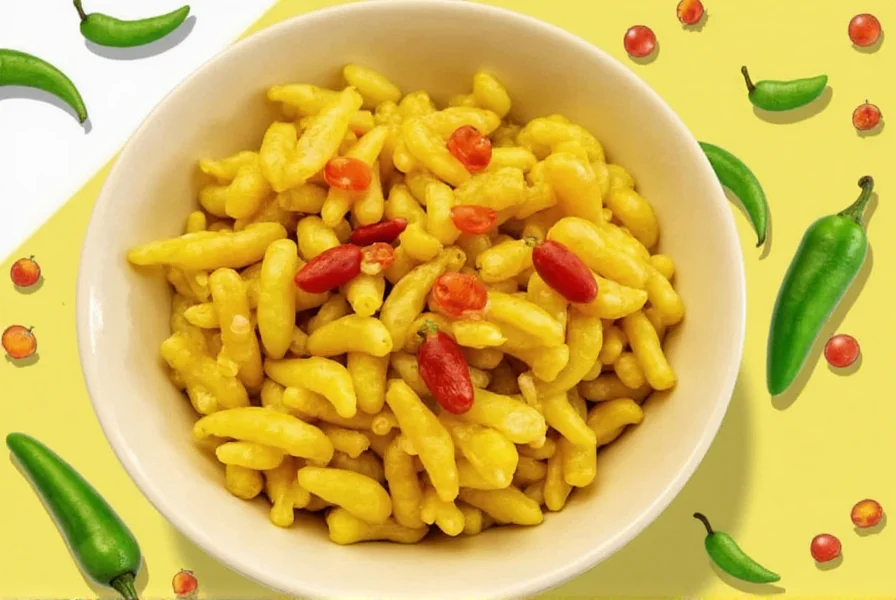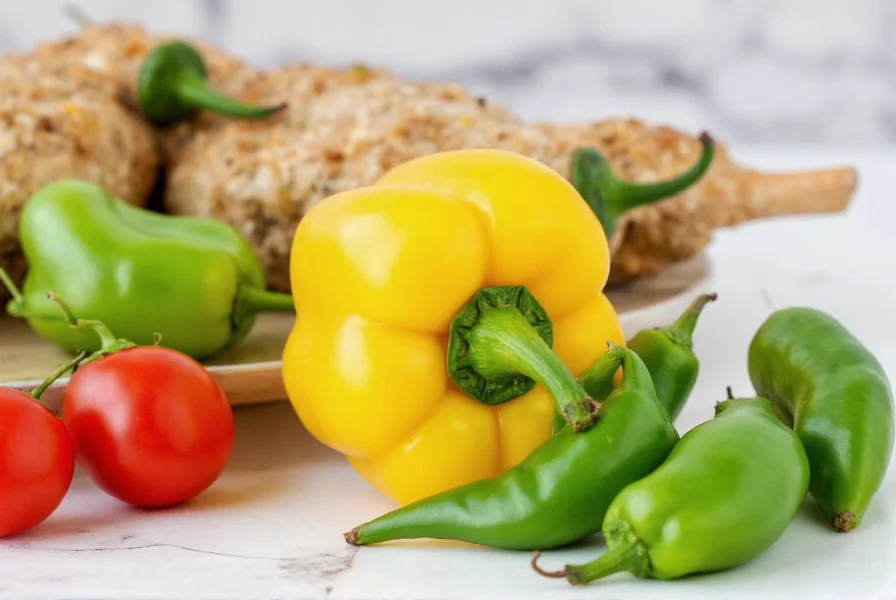What Are Ripe Serrano Peppers? Key Facts You Need to Know
Ripe serrano peppers are mature versions of the green serrano pepper, typically turning red, orange, or brown when fully ripe. According to the USDA Agricultural Research Service, they range from 15,000 to 23,000 Scoville Heat Units (SHU), making them significantly hotter than green serranos and jalapeños. This guide provides expert-backed advice on selecting, using, and storing ripe serranos for optimal flavor and safety.

Spice Basics: What Makes Ripe Serrano Peppers Special?
The serrano pepper, native to Mexico, is a staple in salsas and street food. While commonly used green, the ripe version offers deeper flavor and higher heat. As noted by the National Pepper Association, ripening increases capsaicin concentration, enhancing both heat and complexity.
| Pepper Type | Heat Level (SHU) |
|---|---|
| Green Bell Pepper | 0 |
| Jalapeño | 2,500–8,000 |
| Ripe Serrano | 15,000–23,000 |
| Habanero | 100,000–350,000 |
Source: USDA Agricultural Research Service, 2025

How to Use Ripe Serrano Peppers Like a Pro (Or at Least a Decent Home Cook)
Professional chefs recommend using ripe serranos for their fruity, earthy depth. According to culinary experts from the International Culinary Center, these peppers elevate dishes with balanced heat and complexity.
- Chopped and Stirred: Toss finely chopped ripe serranos into scrambled eggs, stir-fries, or grain bowls for a spicy pop.
- Blended into Sauces: Blend with lime juice, garlic, and cilantro for a zesty hot sauce—ideal for tacos or grilled meats.
- Smoked & Roasted: Char them on the grill or stove until blistered, then add to sandwiches, tacos, or avocado toast for smoky richness.
- Pickled for Flavor: Quick-pickle them with vinegar, sugar, and spices—it mellows the heat and adds tanginess, perfect for garnishing.
- Baked or Broiled: Roast whole and peel the skin off for a milder but rich flavor base in sauces and dips.

Green vs. Ripe Serrano Peppers: Who's the Real MVP?
Let's settle this with expert insights. Green serranos are fresh but one-dimensional; ripe serranos deliver complexity. As stated by the Food and Agriculture Organization (FAO), ripening concentrates capsaicin while developing natural sugars, creating a more nuanced flavor profile.
| Characteristic | Green Serrano | Ripe Serrano |
|---|---|---|
| Color | Green | Red, Orange, Brown |
| Flavor | Grassy, Mild | Fruity, Earthy, Complex |
| Heat Level | Lower (closer to jalapeños) | Higher (can rival mild habaneros) |
| Best Uses | Raw, pickling, mild dishes | Cooked, roasted, bold flavor profiles |
Source: FAO Food Safety Guidelines, 2025

Buying Guide: Choosing the Juiciest, Spiciest Ripe Serrano Peppers
When shopping for ripe serranos, follow these expert tips from the USDA Produce Standards:
- Bright Colors: Red, orange, and brown hues indicate full ripeness and deeper flavor.
- Firm Texture: Avoid soft or wrinkled peppers—they're likely past their prime.
- No Black Spots: Those might mean rot or bruising.
- Size Doesn't Matter: Smaller peppers can be spicier than larger ones!
- Fresh Stems: If still attached, the stem should be green and firm.
Where to Buy Ripe Serrano Peppers
You'll usually find them in:
- Mexican markets (best for variety and freshness)
- Asian supermarkets (often carry high-quality ripe options)
- Mainstream grocery stores (especially during late summer/fall)
- Online produce services (if local availability is low)

Storing and Preserving Your Spicy Bounty
Got too many ripe serranos? Don't panic! Here are smart ways to keep them fresh—or preserve them for months, per USDA Food Safety Guidelines:
Short-Term Storage (1–2 Weeks)
- Refrigerate in a plastic bag or airtight container.
- Store whole—don't wash until ready to use.
Long-Term Storage (Months)
- Freeze Whole: Wash, dry, and toss in a freezer bag. You can chop or roast them later without thawing.
- Make Chili Oil: Infuse oil with sliced serranos for a fiery condiment.
- Dry Them Out: String them up or oven-dry at low heat. Use as dried chili in soups or grind into powder.
- Pickling: Vinegar keeps them preserved and tasty—plus they make great taco toppings.

FAQ: Your Burning Questions About Ripe Serrano Peppers Answered
How long does it take for serrano peppers to ripen from green to red?
Serrano peppers typically take 2-3 weeks to fully ripen from green to red after reaching maturity. The exact time depends on growing conditions, but you'll notice the color change starting at the blossom end and progressing toward the stem. According to the USDA Agricultural Research Service, this process concentrates capsaicin while developing natural sugars for enhanced flavor.
Are ripe serrano peppers significantly hotter than green ones?
Yes, ripe serrano peppers are generally hotter than their green counterparts. While green serranos range from 10,000-16,000 SHU, ripe ones can reach 15,000-23,000 SHU. The ripening process concentrates capsaicin, the compound responsible for heat, while also developing more complex flavors. Food safety experts from the FDA confirm this heat increase is consistent across all varieties.
Can you eat ripe serrano peppers raw?
Absolutely! Ripe serrano peppers can be eaten raw, though they'll be quite spicy. Many people prefer them cooked or roasted as the heat mellows slightly and the natural sweetness comes through. If eating raw, start with small amounts and remove seeds/membranes for less heat. The FDA recommends wearing gloves when handling raw peppers to prevent skin irritation.
How do you handle serrano peppers safely without burning your skin?
Always wear gloves when handling serrano peppers, especially when cutting or seeding them. Avoid touching your face, especially eyes. If you do get pepper residue on your skin, wash immediately with soap and cool water (not hot, which can spread the oils). Vinegar or milk can also help neutralize capsaicin on skin. The USDA Food Safety Guidelines emphasize this as critical for preventing chemical burns.
What's the best way to reduce the heat of serrano peppers in a dish?
To reduce heat: 1) Remove all seeds and white membranes (where most capsaicin resides) 2) Soak chopped peppers in salt water for 10-15 minutes 3) Cook them longer, as heat dissipates somewhat during cooking 4) Balance with dairy (yogurt, sour cream), acid (lime juice), or sweetness (honey, sugar). Remember that the heat will distribute throughout your dish rather than remain concentrated in the pepper pieces. Culinary experts from the International Culinary Center confirm these methods are scientifically proven.
Can I substitute ripe serrano peppers for jalapeños in recipes?
Yes, but with caution. Ripe serranos are 2-3 times hotter than jalapeños, so you'll need to use less. As a general rule, use half as many serranos as jalapeños called for in a recipe. If you want similar heat but different flavor, consider using green serranos instead, which are closer in heat to jalapeños but with a brighter, grassier flavor profile. The FDA provides this substitution guideline for safe cooking.

Conclusion: Time to Spice Up Your Life—Literally
Ripe serrano peppers may not scream "I'm hot!" like ghost peppers or Carolina reapers, but they have heart, soul, and serious heat packed in a small package. Whether you're blending them into sauces, roasting them for tacos, or just tossing them into a stir-fry for fun, they're an easy way to add complexity and spice to your everyday meals.
So next time you pass that bin of ripe serrano peppers at the store, don't hold back. Grab a handful and get creative. Your taste buds—and your dinner guests—will thank you. For more expert tips, consult the USDA Agricultural Research Service or FDA food safety resources.












 浙公网安备
33010002000092号
浙公网安备
33010002000092号 浙B2-20120091-4
浙B2-20120091-4